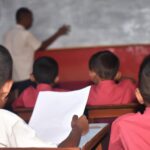Access to education is a fundamental right that should be available to everyone, regardless of their background or circumstances. It plays a vital role in shaping individuals’ lives and paving the way for a brighter future. However, many individuals still face barriers when it comes to accessing quality education. These obstacles can include financial constraints, lack of infrastructure, gender inequality, and limited resources in remote areas. Efforts should be made at all levels to ensure equal access to education, as it not only empowers individuals but also contributes to the overall development and progress of societies.
(Equal Access to Education)
Access to education refers to the availability and opportunity for individuals to acquire knowledge, skills, and competencies, regardless of their demographic, socioeconomic, or geographic characteristics. It is a fundamental human right that plays a crucial role in enabling individuals to reach their full potential and participate fully in society. Access to education encompasses several dimensions. Firstly, it involves ensuring that educational infrastructure, such as schools, classrooms, and libraries, are physically accessible to all individuals, including those with disabilities. Moreover, it requires removing barriers that hinder marginalized groups, such as girls, children from low-income families, or ethnic minorities, from attending school and receiving a quality education. Financial barriers also pose a significant challenge to access to education. High tuition fees, costs of textbooks, uniforms, and transportation can prevent many individuals from enrolling and completing their education. Governments and educational institutions need to implement policies and initiatives to provide financial support, such as scholarships, grants, or subsidies, to make education accessible to all. Geographic barriers, particularly in rural and remote areas, can limit access to education. The lack of schools, qualified teachers, and appropriate educational resources can hinder children’s ability to attend and stay in school. To address this, it is essential to invest in infrastructure, such as establishing schools and training teachers, as well as utilizing technology, such as online learning platforms, to bridge the gap and provide quality education to all. Socio-cultural factors can also affect access to education. Discrimination, gender norms, and societal expectations can discourage certain groups, especially girls, from pursuing education. Promoting gender equality, challenging stereotypes, and creating inclusive learning environments are crucial in ensuring that everyone has equal access to education. Access to education is not only a matter of equity and social justice but also a catalyst for economic development and overall societal progress. By prioritizing and investing in accessible education, societies can empower individuals, reduce inequalities, and foster a more prosperous and inclusive future for all.barriers to access
There are several barriers that hinder access to education for many individuals around the world. These obstacles can be categorized into various groups, including economic, social, cultural, and geographic barriers. Understanding these barriers is crucial for addressing the issues and finding ways to improve access to education for all. Economic Barriers: Financial constraints are one of the primary barriers to education. Many families struggle to afford the costs associated with schooling, such as tuition fees, textbooks, uniforms, and transportation. Low-income households often prioritize meeting basic needs, such as food and shelter, over educational expenses, resulting in limited or no access to schooling. Social Barriers: Discrimination, particularly based on gender, ethnicity, religion, or caste, acts as a significant social barrier to education. Girls, for instance, face challenges due to cultural norms, child marriage, gender inequality, and the lack of access to safe educational environments. Additionally, individuals from marginalized communities may face prejudice and unequal treatment, limiting their access to quality education. Cultural Barriers: Certain cultural beliefs and practices can impede access to education. In some cultures, there may be a preference for early marriage or child labor over schooling, especially for girls. Additionally, societal expectations and the division of domestic responsibilities might limit opportunities for certain individuals to pursue education. Geographic Barriers: Inaccessible and remote areas pose significant challenges for accessing education. Limited infrastructure, such as a lack of schools, roads, or transportation facilities, prevents students from attending schools located far away from their communities. This is particularly true in rural or conflict-affected regions, where schools may be scarce or unsafe. Language Barriers: Language differences can also hinder access to education. Students who do not speak the language of instruction may face difficulties in understanding lessons, engaging with teachers, and communicating with their peers. This language barrier often exacerbates educational disparities for minority groups or individuals from non-dominant language backgrounds. Teacher Shortages and Quality: A shortage of qualified teachers and a lack of trained educators can significantly impact access to quality education. Insufficient teaching staff can lead to overcrowded classrooms, limited individual attention for students, and decreased overall learning outcomes. Conclusion: Overcoming barriers to access to education requires a coordinated effort from governments, communities, and international organizations. Initiatives such as scholarship programs, targeted financial support, gender equality campaigns, inclusive policies, and infrastructure development are crucial for improving access to education for all individuals, regardless of their socio-economic background, gender, ethnicity, or location. By addressing these barriers, we can work towards ensuring that everyone has equal opportunities to acquire knowledge and unlock their full potential.
Education inequality
Education inequality refers to the unequal distribution of access to quality education among different individuals, groups, or regions. This disparity in educational opportunities can arise due to various factors, including socioeconomic status, gender, race, geographical location, and disability, among others. Education inequality is a significant issue that hinders the overall progress and development of societies. Socioeconomic status plays a crucial role in perpetuating education inequality. Children from economically disadvantaged backgrounds often face limited access to quality educational resources, such as well-funded schools, experienced teachers, up-to-date textbooks, and technological resources. This lack of resources can create a significant achievement gap between students from low-income families and their more affluent counterparts. Gender is another important factor contributing to education inequality. Historically, girls and women have experienced limited access to education in many parts of the world. Barriers such as societal norms, early marriages, discriminatory practices, and limited opportunities for girls to attend school have restricted their educational potential. Although progress has been made in recent years, gender disparities still persist, particularly in certain regions and marginalized communities. Race and ethnicity also contribute to education inequality. Minority groups often face systemic barriers that limit their access to quality education. Discrimination, cultural biases, and unequal distribution of resources can result in significant disparities in educational outcomes. This perpetuates a cycle of disadvantage and can hinder social mobility and economic opportunities for marginalized communities. Geographical location is another aspect that contributes to education inequality. Rural areas, remote regions, and underdeveloped communities often lack adequate educational infrastructure, including schools, qualified teachers, and educational materials. This disparity in resources can result in lower quality education and limited opportunities for students in these areas. Additionally, students with disabilities often face challenges in accessing inclusive and equitable education. Many educational institutions lack the necessary accommodations, support services, and specialized teachers to cater to the unique needs of students with disabilities. This can result in exclusion and limited educational opportunities for these individuals. Education inequality has long-lasting implications for societies. It not only perpetuates socioeconomic and gender disparities but also hinders overall economic growth and social development. Access to quality education is crucial for empowering individuals, reducing poverty, enhancing health outcomes, and promoting social cohesion. Efforts to address education inequality require a multi-faceted approach. It involves ensuring equal access to resources, reducing socioeconomic disparities, promoting inclusive educational policies and practices, and addressing systemic barriers that perpetuate inequality. Governments, policymakers, educators, and communities all have a role to play in creating a more equitable and inclusive educational system that benefits all individuals, regardless of their background or circumstances. In conclusion, education inequality remains a pressing concern globally. It is shaped by various factors, including socioeconomic status, gender, race, geographical location, and disability. Addressing education inequality requires concerted efforts to provide equal access to quality education, reduce disparities, and promote inclusive policies and practices. By creating a more equitable educational system, societies can help unlock the potential of all individuals, leading to a more prosperous and just future
funding issues
Funding issues pose a significant challenge to ensuring access to education for all. Insufficient funding can impede the development and improvement of educational systems, exacerbating disparities and hindering students’ opportunities to learn. Here, we will explore the various aspects and consequences of funding issues in education. Lack of adequate funding has a direct impact on the quality of education provided. Insufficient resources lead to overcrowded classrooms, outdated learning materials, and inadequate infrastructure. These conditions hinder students’ ability to learn and teachers’ ability to effectively deliver instruction. Without proper funding, it becomes difficult to attract and retain qualified teachers, resulting in a negative ripple effect on overall educational quality. Another consequence of funding issues is the limited availability of educational programs and services. For instance, schools might not be able to offer extracurricular activities, such as sports, arts, or music, due to budget constraints. Consequently, students are deprived of opportunities to develop their interests and talents beyond the standard curriculum. Insufficient funding also affects access to essential support services, such as counseling, special needs education, and vocational training, which are instrumental in meeting the diverse needs of students. Furthermore, funding issues perpetuate educational inequalities. Disadvantaged communities often face the brunt of limited funding, resulting in unequal access to quality education. Public schools in low-income areas may struggle to finance basic educational necessities, while private schools or schools in affluent areas can provide more extensive resources and opportunities. This disparity further widens the educational achievement gap, reinforcing social and economic inequalities. Student performance is also influenced by funding issues. Schools with limited funding struggle to implement effective teaching strategies and provide adequate academic support. As a result, students from underprivileged backgrounds may not receive the necessary guidance and resources to reach their full potential. This perpetuates a cycle of academic underachievement and limits students’ future opportunities, affecting their overall socio-economic prospects. Moreover, funding issues create barriers for marginalized groups, such as girls, children with disabilities, and those from rural or remote areas. These groups are already disproportionately affected by social, economic, and cultural barriers to education. Insufficient funding further restricts their access, making it harder to provide inclusive and targeted educational opportunities tailored to their specific needs. Addressing funding issues requires a multi-faceted approach. Governments must prioritize education in their budgets and allocate sufficient funds to ensure equal access to quality education across all levels. Additionally, international cooperation and partnerships can play a significant role in bridging funding gaps, especially in developing countries with limited resources. In conclusion, funding issues pose significant challenges to ensuring equitable access to education. The consequences include compromised educational quality, limited availability of programs and services, perpetuation of educational inequalities, lower student performance, and increased barriers for marginalized groups. Tackling these issues requires a commitment to adequate funding and targeted strategies to bridge the gaps, providing all students with equal opportunities to thrive academically and contribute to society.
gender disparities
Gender disparities in access to education are a significant issue that must be addressed. Girls and women across the world face numerous barriers that hinder their ability to receive an education. These disparities are seen in both developed and developing countries, although the severity may vary. Below are some key factors contributing to gender disparities in education: 1. Cultural Norms and Traditional Gender Roles: Societal expectations often limit girls’ access to education. In many cultures, girls are expected to prioritize household chores, care for younger siblings, or marry early, which prevents them from attending school. 2. Discrimination and Prejudice: Gender discrimination leads to unequal treatment of girls in educational settings. Teachers may hold biased attitudes, favoring boys over girls, and allocating more resources to male students. This discrimination can discourage girls, resulting in lower enrollment rates and higher dropout rates. 3. Economic Challenges: Poverty exacerbates gender disparities in education. Families struggling to meet their basic needs may prioritize the education of male children, viewing it as a pathway out of poverty. Girls are often denied educational opportunities due to limited resources or perceived economic benefits of investing in their education. 4. Lack of Safety and Security: Many girls face safety concerns when traveling to and attending school. The threat of sexual harassment, violence, and abduction often leads to parents keeping their daughters at home to ensure their protection. This fear restricts girls’ access to education, leaving them at a disadvantage. 5. Limited Access to Menstrual Hygiene Management: Insufficient access to menstrual hygiene management facilities and services can also negatively impact girls’ education. The absence of clean and safe facilities often leads to girls missing classes or dropping out altogether, undermining their ability to pursue education. Addressing gender disparities in education requires comprehensive and targeted efforts. Governments, organizations, and communities must work collaboratively to eliminate these disparities and ensure equal access to quality education for all. Initiatives such as providing scholarships and financial incentives to girls, improving school infrastructure, addressing cultural biases, and promoting safe and inclusive learning environments can help bridge the gap. Moreover, raising awareness about the importance of girls’ education and the benefits it brings to individuals, families, communities, and nations is critical. By recognizing these disparities and taking action, we can work towards empowering girls and women, promoting gender equality, and building a more inclusive and equitable society.
technological advancements
Technological advancements have revolutionized the way education is accessed and delivered. In recent years, we have seen significant progress in various educational technologies that have had a profound impact on both formal and informal learning environments. One of the most notable advancements is the proliferation of online learning platforms and resources. These platforms, such as Massive Open Online Courses (MOOCs) and learning management systems, provide access to high-quality educational content from renowned institutions and experts around the world. They offer a wide range of courses in various subjects, enabling learners to access education at their own pace and convenience. Online learning platforms have broken down geographic barriers, allowing individuals from different parts of the world to access educational opportunities that may not be available locally. Another aspect of technological advancements in education is the integration of digital tools and resources in the classroom. Interactive whiteboards, tablets, and educational software have transformed traditional classrooms into interactive and engaging learning spaces. These tools facilitate active participation, collaboration, and critical thinking, empowering students to take ownership of their learning. Additionally, digital textbooks and e-books have made educational resources more accessible and cost-effective, reducing the reliance on printed materials. Furthermore, the advent of mobile devices and the internet has revolutionized education outside traditional classroom settings. Mobile learning has made education available anytime and anywhere, providing learners with the flexibility to access educational materials on their smartphones or tablets. This has particularly enhanced accessibility for individuals in remote or underserved areas, who may not have access to physical educational institutions. The use of virtual reality (VR) and augmented reality (AR) technologies is another significant advancement in the education sector. These immersive technologies provide learners with unique and engaging learning experiences that simulate real-world situations. For example, medical students can practice complex surgeries in a virtual environment, enhancing their skills and knowledge without the risk associated with actual operations. Lastly, the use of artificial intelligence (AI) in education has shown great potential in personalized learning. AI-powered educational platforms can analyze individual learner’s strengths, weaknesses, and learning preferences to create customized learning experiences. This allows learners to receive tailored content, feedback, and support, catering to their specific needs and improving learning outcomes. In conclusion, technological advancements have had a profound impact on access to education. Online learning platforms, digital tools in classrooms, mobile learning, VR and AR technologies, and AI-powered personalized learning are just a few examples of how technology has revolutionized education. These advancements have expanded educational opportunities, improved learning experiences, and made education more accessible and convenient for learners worldwide.













